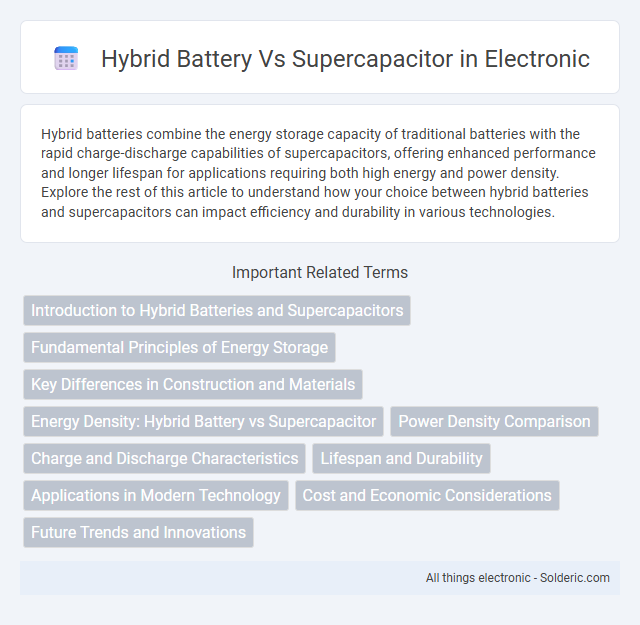Hybrid batteries combine the energy storage capacity of traditional batteries with the rapid charge-discharge capabilities of supercapacitors, offering enhanced performance and longer lifespan for applications requiring both high energy and power density. Explore the rest of this article to understand how your choice between hybrid batteries and supercapacitors can impact efficiency and durability in various technologies.
Comparison Table
| Feature | Hybrid Battery | Supercapacitor |
|---|---|---|
| Energy Density | High (50-150 Wh/kg) | Low (5-10 Wh/kg) |
| Power Density | Medium (up to 1000 W/kg) | Very High (up to 10,000 W/kg) |
| Charge/Discharge Speed | Moderate (minutes to hours) | Very Fast (seconds) |
| Cycle Life | Moderate (1000-5000 cycles) | Extremely High (100,000+ cycles) |
| Applications | Electric vehicles, renewable energy storage, portable electronics | Energy recapture, power smoothing, backup power, quick bursts |
| Cost | Higher due to chemical complexity | Lower operational cost, higher initial investment |
| Weight | Heavier | Lighter |
| Operating Temperature | Limited (0degC to 45degC) | Wide (-40degC to 70degC) |
Introduction to Hybrid Batteries and Supercapacitors
Hybrid batteries combine the high energy density of batteries with the rapid charge and discharge capabilities of supercapacitors, providing efficient energy storage and delivery systems. Supercapacitors store energy through electrostatic fields, enabling faster charge cycles and longer lifespans compared to conventional batteries. The integration of hybrid batteries and supercapacitors offers enhanced performance for electric vehicles, renewable energy systems, and portable electronics.
Fundamental Principles of Energy Storage
Hybrid batteries combine the chemical energy storage of traditional batteries with the rapid charge-discharge capabilities of supercapacitors, leveraging electrochemical reactions alongside electrostatic energy storage. Supercapacitors store energy through electric double-layer capacitance, enabling quick energy delivery but lower energy density compared to batteries. Your choice between these technologies depends on the required balance of energy capacity, power output, and recharge speed for specific applications.
Key Differences in Construction and Materials
Hybrid batteries combine electrochemical cells with specialized electrodes and electrolytes, typically using lithium-ion technology for high energy density and long cycle life. Supercapacitors utilize porous carbon-based electrodes and electrolytes that enable rapid charge and discharge with lower energy density but superior power density and lifespan. Understanding the distinct construction and materials of these devices helps you choose the optimal energy storage solution for your specific application.
Energy Density: Hybrid Battery vs Supercapacitor
Hybrid batteries offer significantly higher energy density compared to supercapacitors, enabling longer-lasting power storage suitable for applications requiring sustained energy output. Supercapacitors excel in delivering rapid charge and discharge cycles but have much lower energy density, making them ideal for short bursts of power rather than extended use. Your choice depends on whether you prioritize prolonged energy storage or quick, repetitive energy delivery.
Power Density Comparison
Hybrid batteries exhibit higher energy density but generally have lower power density compared to supercapacitors, which excel in rapid charge and discharge cycles due to their superior power density. Supercapacitors can deliver power densities exceeding 10,000 W/kg, significantly outperforming hybrid batteries that typically range between 200 to 2,000 W/kg. This makes supercapacitors ideal for applications requiring quick bursts of energy, whereas hybrid batteries balance energy storage and power output for longer-duration uses.
Charge and Discharge Characteristics
Hybrid batteries exhibit higher energy density and slower charge-discharge cycles, suitable for applications demanding sustained power delivery, while supercapacitors offer rapid charge and discharge rates due to their high power density, ideal for short bursts of energy. Supercapacitors can endure over a million charge-discharge cycles with minimal degradation, contrasting with hybrid batteries that have a limited cycle life ranging from several hundred to a few thousand cycles. These distinct charge-discharge characteristics influence their use cases, where hybrid batteries favor long-term energy storage, and supercapacitors excel in quick-energy delivery and regeneration scenarios.
Lifespan and Durability
Hybrid batteries exhibit longer lifespan and enhanced durability compared to traditional batteries due to their ability to balance chemical energy storage with electrical double-layer capacitance. Supercapacitors provide exceptional durability with millions of charge-discharge cycles and superior tolerance to extreme temperatures, yet generally have shorter energy storage capacity. Combining these technologies in hybrid systems maximizes overall lifespan and operational efficiency by leveraging the high energy density of batteries and the rapid charge-discharge capabilities and extended cycle life of supercapacitors.
Applications in Modern Technology
Hybrid batteries combine high energy density with moderate power output, making them ideal for electric vehicles and renewable energy storage systems where long-lasting energy supply is crucial. Supercapacitors excel in rapid charge and discharge cycles, finding applications in regenerative braking systems, power backup, and burst power devices such as portable electronics and industrial machines. The integration of both technologies in hybrid energy storage solutions enhances performance by balancing energy density and power delivery in modern smart grids and advanced transportation systems.
Cost and Economic Considerations
Hybrid batteries typically have higher upfront costs due to complex materials and manufacturing processes, but their longer lifespan and energy density can offer better value over time. Supercapacitors generally have lower initial expenses and superior charge-discharge cycles, yet their higher self-discharge rates and lower energy storage capacity may require more frequent replacements or supplementary systems. Evaluating the total cost of ownership, including maintenance, efficiency, and application requirements, is crucial for economically optimizing energy storage investments.
Future Trends and Innovations
Hybrid battery and supercapacitor technologies are converging with advancements in energy density, charge cycles, and thermal management to create more efficient, long-lasting power solutions for electric vehicles and renewable energy storage. Innovations such as solid-state electrolytes and graphene-enhanced electrodes promise to enhance the energy capacity and rapid charging capabilities of hybrid systems. Your future devices could benefit from these breakthroughs, offering improved performance and sustainability while reducing the limitations of traditional batteries and supercapacitors.
Hybrid battery vs Supercapacitor Infographic

 solderic.com
solderic.com